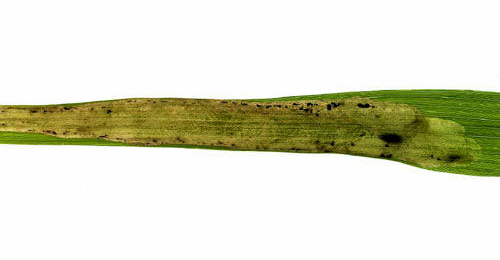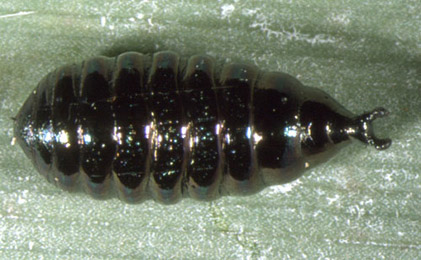|
||||||
| Cerodontha phragmitidis Nowakowski, 1967 [Diptera: Agromyzidae] |
|||||||||||||||||||||||||||||||||||||||||||||||||||||||
|
Cerodontha
(Poemyza) phragmitidis Nowakowski, 1967. Polskie Pismo
ent. 37(4): 647 |
|||||||||||||||||||||||||||||||||||||||||||||||||||||||
Leaf-miner: A large linear-blotch mine in the leaf blade. Pupation normally in the mine (Spencer, 1976: 190). Elongated blotch, usually in the distal part of the blade. The mine is mostly interparenchymatous, less frequently lower-surface, and rarely upper-surface. Rather little frass, in fairly large grains, scattered in the mine. Larva generally solitary. Pupation almost always within the mine (Bladmineerders van Europa). Larva: The larvae of flies are leg-less maggots without a head capsule (see examples). They never have thoracic or abdominal legs. They do not have chewing mouthparts, although they do have a characteristic cephalo-pharyngeal skeleton (see examples), usually visible internally through the body wall. The larva is illustrated in Bladmineerders van Europa. Puparium: The puparia of flies are formed within the hardened last larval skin or puparium and as a result sheaths enclosing head appendages, wings and legs are not visible externally (see examples). Metallic black, deeply segmented, narrowing at hind end; posterior spiracular processes knob-like, each with 3 bulbs, at each corner of a large, almost rectangular projection (Spencer, 1976: 190). The puparium is illustrated in Bladmineerders van Europa.
Hosts in Great Britain and Ireland:
Hosts elsewhere:
Time of year - mines: June-September, less often also May and October (Bladmineerders van Europa). Time of year - adults: Currently unknown. Distribution in Great Britain and Ireland: Widespread (Spencer, 1972b 104) including Warwickshire (Dosthill) (Robbins, 1991: 137); Cambridgeshire and Glamorgan (NBN Atlas). Distribution elsewhere: Widespread in continental Europe including Denmark, Sweden and Estonia (Spencer, 1976: 190), The Netherlands (Bladmineerders van Europa), Belgium (Scheirs and de Bruyn, 1992) and Germany (Spencer, 1976: 554), Czech Republic, French mainland, Hungary, Lithuania and Poland (Fauna Europaea). Also recorded in Japan (Spencer, 1976: 190). NBN Atlas links to known host species:
British and Irish Parasitoids in Britain and elsewhere:
|
|
|
|
| External links: | Search the internet: |
| Biodiversity Heritage Library Bladmineerders van Europa British leafminers Encyclopedia of Life Fauna Europaea NBN Atlas NHM UK Checklist |
Find
using Google Find using Google Scholar Find images using Google |
| Last updated 09-Jul-2019 Brian Pitkin | ||


